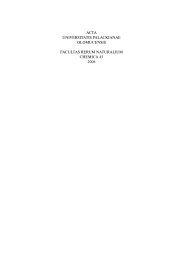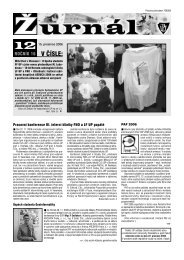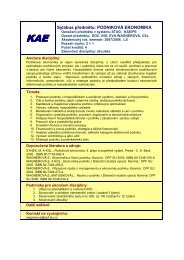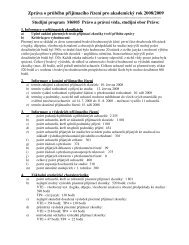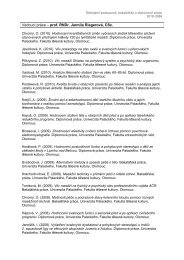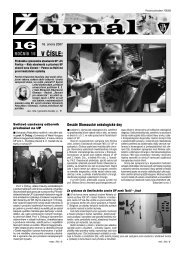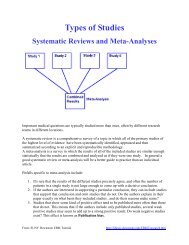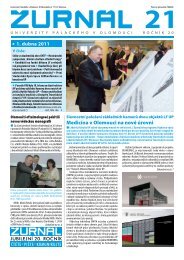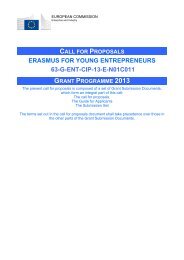46 Acta Univ. Palacki. Olomuc., Gymn. 2004, vol. 34, no. 2H1 During a rhythmised respiratory frequency of 12cycles/min. frequency stabilisation appears in all examinedsubjects connected with respiration frequency(respiratory bound vagus activity) in the region of0.2 Hz. During spontaneous respiration this respiratorybound frequency will depend on individual respiratoryfrequency.H2 During so-called full yoga respiration characterisedby higher air volume and lower respiration frequencyof less than 9 cycles/min. (interval T6), we found anincrease in the total spectral power in ms 2 in comparisonwith spontaneous respiration.H3 By the influence of a decrease of average respirationfrequency of less than 9 cycles/min. during intensifiedrespiration in the measured interval T6, there occursa frequency shift of respiratory bound vagus activityfrom the high frequency zone HF during spontaneousrespiration (interval T5) to the zone of frequency componentLF during intensified respiration as comparedwith a spontaneous respiration frequency of more than9 cycles/min. (interval T5).H4 Increase in a total spectral power in ms 2 at intervalsT6, T8 with intensified respiration is directly related toan increase in vagus activity.H5 During tachypnoe in the respiratory technique ofkapalabhaty (respiratory frequency approximately 120cycles/min.) there occurs a shift of respiratory boundvagus activity above the upper frequency level of 0.4 Hzdetermined to be the upper frequency zone in the diagnosticsystem Vario pulse TF4. The dominant frequencyin the zone of HF will not be bound to respiration underthese conditions.METHODResearch methodThe experiment was conducted under laboratoryconditions with goal-directed manipulation of independentvariables (position, respiratory pattern). Allparticipants in the experiment were selected by drawfrom a group of students of Faculty of Physical Culture,Palacký University. The room temperature was 20°C; themeasurements were always conducted in the morninghours. The first stage of the experiment measured theresting reactivity of heart rate variability in supine-standing-supinepositions at the rhytimized breathing frequencyof 12 cycles/min. and then in the supine position atspontaneous respiration frequency. The second stagemeasurements were monitored in subsequent intervalswith the subjects in sitting position performing spontaneousrespiration, respectively applying the breathingtechnique of spontaneous respiration.Subjects18 men and women; aged 20–25 years, = 22.1years, BMI = 23.4 healthy individuals not on medication,non-smokers, 24 hours prior to the examinationthere had to be an absence of elevated physical load aswell as of alcohol use.Used instrumentationChanges in the actual functional state of the autonomousnervous system under the influence of respiratorytechniques were assessed by the method of short-termspectral analysis of heart rate variability using the telemetricsystem of Vario TF4. Each examined intervalrecorded a section of 300 beats, respectively 5 minutesof recording.The diagnostic system of Vario TF4 allows for thethorough scanning of an EKG signal registering seriesof successive R-R intervals and, with the use of a softwaresystem, allows for the carrying out of the methodof Fourier’s fast transformation of subsequent spectralanalysis in the region of 0.02–0.4 Hz which is regardedas the frequency zone corresponding to ANS activity.The result of SAHRV and respectively of monitoredR-R intervals is graphic and numerical analysis at thefrequency level of 0.02–0.4 Hz. In this frequency zonethere are three partial frequency components analysedby the software system, which are related to the activityof partial ANS subsystems.• Very Low Frequency – VLF within the range of0.02–0.05 Hz. This frequency component is notstrictly identified and is usually related to thethermoregulative sympathetic activity of vesselsand also to the level of circulating katecholaminsand to fluctuations in the renin-angiotensinsystem. Regarding the fact that there are very slowfrequencies ranging from 0.6–3.0 rhythms/min., theinterpretation of functional changes in this zone bymeans of the short-term analysis of pulse frequencyvariability is rather difficult.• Low Frequency – LF within the range of 0.05–0.150 Hz.This frequency component is related to slow fluctuationsin arterial pressure and is infl uenced by thebarorefl ective sympathetic activity of vessels (theso-called Mayer’s pressure wave) with a frequencydomain in this frequency range. According to Malik(1998) the frequency component LF is also infl u-enced by parasympathetic activity.• High Frequency – HF within the range of 0.151–0.4 Hz.According to Malik (1998) this component is influencedentirely by efferent vagus activity. Duringrhythmised respiratory frequency of 10 or more
Acta Univ. Palacki. Olomuc., Gymn. 2004, vol. 34, no. 2 47cycles/min. it is possible within this frequency rangeto exactly identify the frequency bound to respiration,which we regard as parasympathetic respiratorybound activity. Depending on the frequency ofrespiration, frequency shifts of this component occurup to the range assessed as the frequency range ofLF. Apart from parasympathetic respiratory boundactivity, we found in this frequency zone other subdominantfrequencies whose origin remains unclear.These subdominant frequencies in the HF zone arerelated probably to the modulation of vagus activityinduced by signals from inner organs directedby the parasympathetic system. It is also probablethat harmonic frequencies evoked by respiration frequencyplay an expressive role in these subdominantfrequencies.• The respiratory bound frequency component. Frequencydomain and frequency amplitude boundto respiration, which we regard as parasympatheticrespiratory bound activity, is expressively bound torhythmisation of respiratory frequency and stabilityof respiratory volume. By rhythmisation or observationof respiratory frequency it is possible to identifythe activity of the respiratory bound frequency component.In people with rhythmised or spontaneousbradypnoe of less than 9 cycles/min., this respiratorybound frequency is found in the zone of LFfrequency. The frequency shift of this respiratorybound component is 0.0167 Hz/1 per respiratorycycle (Kolisko, Salinger, Opavský et al., 1997).By rhythmisation of respiratory frequency at12 cycles/min. and rhythmisation of the length ofinspiration and expiration with a ratio of 2 : 3, it ispossible to stabilise respiratory bound frequency at0.2 Hz.Under these conditions we may unambiguouslyregard the HF zone as a frequency zone of parasympatheticand dominant frequency in the LF zoneas “Mayer’s pressure wave” relating to baroreceptoractivity.Under conditions of stable respiratory frequency,amplitude modulation (spectral power in ms 2 ),which we regard to be respiratorily bound vagus activity,is influenced by respiratory volume. Togetherwith an increase in respiratory volume, the totalspectral power of the respiratory bound frequencycomponent also increases, while with a reduction inrespiratory volume it decreases.Measurement process1. Observation of SAHRV changes, respectively of theactual functional condition of ANS during restingconditions with a rhythmised respiratory frequencyof 12 cycles/min. depending on body position; lying– interval T1, standing – interval T2, lying afterorthostasis – interval T3.2. Observation of SAHRV changes in a lying positiondepending on changes in respiratory rhythm;lying with a rhythmised respiratory frequency of12 cycles/min. – interval T3, lying during spontaneous,observed respiratory frequency – interval T4.3. Observation of respiratory techniques’ effects onchanges of heart rate variability, respectively onchanges of the functional condition of ANS; inan observed position – sitting. Measured intervals:T5 – sit ting, spontaneous respiration, T6 – sitting, intensifiedspontaneous respiration (full yoga breath),T7 – sitting, spontaneous respiration, T8 – sitting,alternate respiration through the right and left nostril(anuloma – viloma), T9 – sitting, spontaneousrespiration, T10 – accelerated shallow diaphragmrespiration (kapalabhaty).Methods used for evaluation and processing of dataobtainedThe length of one scanned interval was 300 beats.Computation of SAHRV parameters was carried outby a software programme in a standard manner accordingto an adjusted algorithm of CGSA (coarse-grainingspectral analysis) IAW Yamamoto & Hughson (1991).The number of parameters characterising ANS activityin the particular frequency zones of VLF, LF, and HFare the results of spectral analysis.Observed functional parameters in individual observedpositions1. Total spectral power in ms 2 .2. Spectral powers of individual frequency componentsVLF, LF, HF in ms 2 .3. Relative spectral powers of frequency componentVLF, LF, HF in % from total spectral power.4. Ratio of spectral powers of individual frequencyzones VLF/HF, LF/HF, VLF/LF.5. Ratio of the radical of spectral powers in the LFand HF (CCVLF, CCVHF) frequency zones as anindicator of total activity in the zone LF and HF.6. The average value of the R-R interval length at measuredintervals in ms (R-R interval).7. Dominant frequency components of VLF, LF, HFin mHz.Statistical method used1. Basic descriptive statistics for data description – arithmetical mean, standard deviation.2. Wilcoxon’s non-parametric test was used foranalysing the signifi cance of changes in observedpara meters depending on the applied respiratorytechnique among selected intervals.
- Page 1 and 2: ACTAUNIVERSITATIS PALACKIANAE OLOMU
- Page 3 and 4: ACTAUNIVERSITATIS PALACKIANAE OLOMU
- Page 5: Acta Univ. Palacki. Olomuc., Gymn.
- Page 8 and 9: 8 Acta Univ. Palacki. Olomuc., Gymn
- Page 10 and 11: 10 Acta Univ. Palacki. Olomuc., Gym
- Page 12 and 13: 12 Acta Univ. Palacki. Olomuc., Gym
- Page 14: 14 Acta Univ. Palacki. Olomuc., Gym
- Page 17: Acta Univ. Palacki. Olomuc., Gymn.
- Page 20 and 21: 20 Acta Univ. Palacki. Olomuc., Gym
- Page 22: 22 Acta Univ. Palacki. Olomuc., Gym
- Page 26 and 27: 26 Acta Univ. Palacki. Olomuc., Gym
- Page 28 and 29: 28 Acta Univ. Palacki. Olomuc., Gym
- Page 32 and 33: 32 Acta Univ. Palacki. Olomuc., Gym
- Page 34 and 35: 34 Acta Univ. Palacki. Olomuc., Gym
- Page 36 and 37: 36 Acta Univ. Palacki. Olomuc., Gym
- Page 38 and 39: 38 Acta Univ. Palacki. Olomuc., Gym
- Page 40 and 41: 40 Acta Univ. Palacki. Olomuc., Gym
- Page 43 and 44: Acta Univ. Palacki. Olomuc., Gymn.
- Page 45: Acta Univ. Palacki. Olomuc., Gymn.
- Page 49 and 50: Acta Univ. Palacki. Olomuc., Gymn.
- Page 51 and 52: Acta Univ. Palacki. Olomuc., Gymn.
- Page 53 and 54: Acta Univ. Palacki. Olomuc., Gymn.
- Page 55 and 56: Acta Univ. Palacki. Olomuc., Gymn.
- Page 57 and 58: Acta Univ. Palacki. Olomuc., Gymn.
- Page 59: Acta Univ. Palacki. Olomuc., Gymn.
- Page 62 and 63: 62 Acta Univ. Palacki. Olomuc., Gym
- Page 64 and 65: 64 Acta Univ. Palacki. Olomuc., Gym
- Page 66 and 67: 66 Acta Univ. Palacki. Olomuc., Gym
- Page 68 and 69: 68 Acta Univ. Palacki. Olomuc., Gym
- Page 70 and 71: 70 Acta Univ. Palacki. Olomuc., Gym
- Page 72 and 73: 72 Acta Univ. Palacki. Olomuc., Gym
- Page 74 and 75: 74 Acta Univ. Palacki. Olomuc., Gym
- Page 76 and 77: 76 Acta Univ. Palacki. Olomuc., Gym
- Page 78 and 79: ACTAUNIVERSITATIS PALACKIANAE OLOMU



